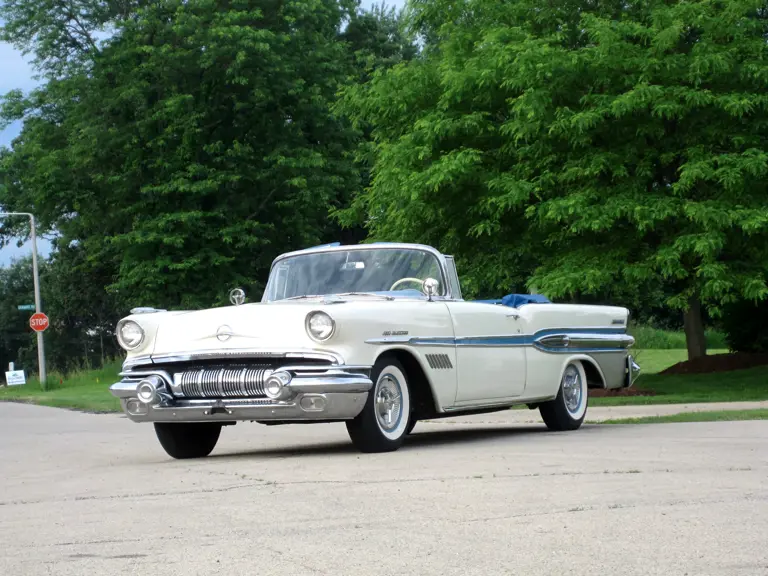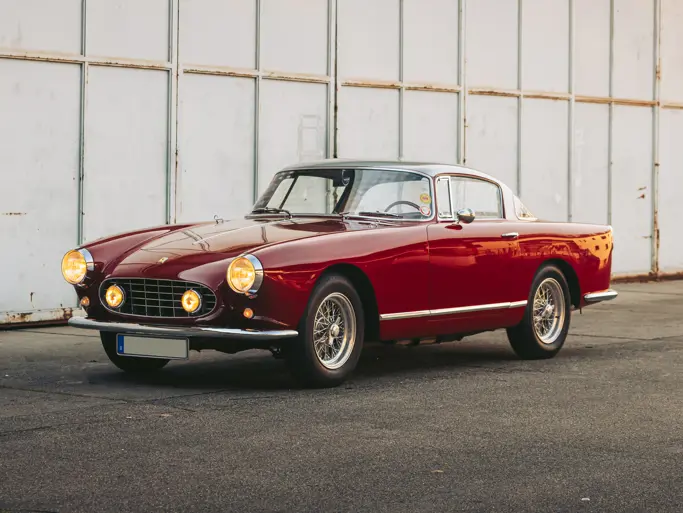
1957 Pontiac Bonneville Fuel-Injected
{{lr.item.text}}
$125,000 - $175,000 USD | Not Sold
{{bidding.lot.reserveStatusFormatted}}
- 347-cid, 315-hp V-8 fuel-injected engine
- Hydra-Matic automatic transmission
- Fastest Pontiac ever produced upon debut
- Expensive when new
- Cadillac-like level of standards
- Only 630 built in limited run
- Desirable color combination
- Released as only one-to-a-dealer
- Rochester fuel injection unit
- Many ammenities, great styling
The Bonneville name first appeared in 1954 on a pair of bubble-topped GM Motorama concept cars called the Bonneville Special. It entered the production lineup as a high-performance, fuel-injected luxury convertible within the Star Chief line in the 1957 model year and was loaded with every conceivable option as standard equipment.
The very first production Bonneville was a spectacular, chrome-laden convertible. When the 1957 Bonneville was introduced on January 11, 1957, it was the fastest Pontiac ever produced. Zero-to-sixty took just 8.1 seconds. Appropriately, the car was named after the Bonneville Salt Flats in Utah, the sight of early automobile contests and numerous assaults on the world land-speed record runs. The $5,782 sticker price was correspondingly high to its low 0- to 60-mph time. For the Cadillac-like price, Bonneville buyers received a Cadillac-like level of standard equipment that included Hydra-Matic automatic transmission, Wonderbar AM radio, underseat heater, defroster, tri-blade wheel covers, Autronic-Eye automatic headlight dimmer, padded dash, full leather interior; power top, eight-way seat, windows, steering, brakes and antenna. This magnificent machine offered only two options; a Continental kit and air conditioning. This rare machine is presented in Kenya Ivory and Fontaine Blue with a blue top and a blue and white leather interior. Additional features include a Kleenex dispenser, factory clock and whitewall tires.
Pontiac wrapped up all of their best in this incomparable package: outside, matchless styling – inside, spacious and gracious comforts. Released as only one-to-a-dealer, Bonneville availability was limited to only 630 production examples.
Power was supplied in abundance by a 347-cid V-8 engine with Rochester mechanical fuel injection pumping out 315 horsepower. Pontiac never released a specific power rating for this engine, simply stating that its output was “in excess of 300 horsepower.” The mechanical fuel injection system was a continuous-flow unit engineered by Harold Barr and Zora Arkus-Duntov. It is considered by some to be a better system than the Chevrolet version, with combined rather than separate manifold heater and pipes, plus a better fuel meter placement. This exceptional unit was bolted to the respected Hydra-Matic automatic transmission and power was delivered to a live rear axle sprung with semi-elliptical leaf springs. Independent front suspension with coil springs and four-wheel hydraulic drum brakes contributed to a luxurious ride.
Styling for the Bonneville was under the direction of division chief stylist Paul Gillan. It represented a second facelift of the design that was introduced for 1955. At the front were newly featured body color hooded headlight rims, illuminated front fender ornaments and a bumper/grille ensemble with a series of vertical slots for a “waterfall” effect that was drawn by future GM styling chief Irv Rybicki. Behind the front wheels, fender hash marks added to the illusion of speed. For the first time in a decade, Pontiac taillights were a shape other than circular; elliptical lenses fit into massive chrome bezels under fins that angled back and up. A sculptured chrome wraparound bumper with integrated dual exhaust outlets finished off the rear styling treatment. Body sides featured rocket silhouette chrome spear trim that ran the full length of the car and provided two-tone paint accents. Stylized “Fuel Injection” badging above the front wheel arches and centered on the trunklid above the bumper boldly announced the level of performance to be delivered. The equally stylish “Bonneville” badging appeared above the spears on the rear fenders.


 | Auburn, Indiana
| Auburn, Indiana


